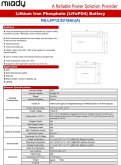I now have a 24V x 96Ah Battery Bank: 12 x 12V x 16Ah LiFePO4 batteries wired in a 2S6P configuration.
Also, for this battery bank, I have 6 x 250W Panels: Vmp = 30.3V, Voc = 37.6V and Imp = 8.27A, Isc = 8.85A. My plan is to wire them 3S3P for 90V x 16.5A nominal to the charge controller. This higher voltage and lower current is a good thing for wire size and/or distance to the MPPT... Yes?
Loads will be intermittent, but will be plugged into a 24vdc-120vac 2000W PSWI. There will be a steady load of about 300W and, on occassion, I will be drawing ~ 1800W from that inverter (300w + 1500w). With 85% efficiency and overhead, that's going to be about 98A @ 24vdc. However, it should only last about 15-30 minutes once or twice a day.
Based on the attached Spec Sheets for the batteries and panels, what charge controller and charge profile would you all recommend?
Many Thanks and God Bless!
Kugel
Also, for this battery bank, I have 6 x 250W Panels: Vmp = 30.3V, Voc = 37.6V and Imp = 8.27A, Isc = 8.85A. My plan is to wire them 3S3P for 90V x 16.5A nominal to the charge controller. This higher voltage and lower current is a good thing for wire size and/or distance to the MPPT... Yes?
Loads will be intermittent, but will be plugged into a 24vdc-120vac 2000W PSWI. There will be a steady load of about 300W and, on occassion, I will be drawing ~ 1800W from that inverter (300w + 1500w). With 85% efficiency and overhead, that's going to be about 98A @ 24vdc. However, it should only last about 15-30 minutes once or twice a day.
Based on the attached Spec Sheets for the batteries and panels, what charge controller and charge profile would you all recommend?
Many Thanks and God Bless!
Kugel



